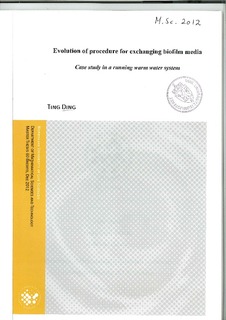Evolution of procedure for exchanging biofilm media : case study in a running warm water system
Master thesis
Permanent lenke
http://hdl.handle.net/11250/189150Utgivelsesdato
2013-10-21Metadata
Vis full innførselSamlinger
- Master's theses (RealTek) [1826]
Sammendrag
Moving bed biofilm reactor (MBBR) is a technology based on the biofilm theory, with
biofilm attached on the suspended medium. Because of the low growth rate of nitrifying
bacteria, the start-up period is quite long. Furthermore, nitrifying bacteria are very sensitive
to water quality variations. Since the RAS is highly depend on biofilter, it poses a big
challenge for the RAS fish farms that plan to exchange biofilm media with fish rearing in the
system. This case study evaluated the procedure of exchanging biofilm media in a running
warm water system. It also followed the developmental process of the “new” Anox K5 and
BiofilmChip M (Krüger Kaldnes AS, Sandefjord, Norway) in a warm water system.
This case study focused on the tilapia warm water RAS of Fish laboratory, Norwegian
University of Life Science (UMB, Ås, Norway). The MBBR includes three chambers.
Chamber 1 (C1) was without biofilm media. Chamber 2 (C2) and chamber 3 (C3) contained a
mixture of Kaldnes K1 (Krüger Kaldnes AS, Sandefjord, Norway) and 1” plastic Pall Rings
(Vereinigte Füllkörper-Fabrikenj GmbH & Co, D-56235 Ransbach-Baumbach).
Because TAN and NO2 levels sometimes exceeded the optimal concentration for Nile tilapia
(Oreochromis niloticus), the fish laboratory decided to exchange the “old” biofilm media in
chamber 2 and 3 (chamber 1 was empty) with Anox K5 and BiofilmChip M. According to the
suggestions given by Krüger Kaldnes AS, chamber 2 (see overview of the chambers in Figure
3.1) of the MBBR should be filled with Anox K5, chamber 3 should be filled with
BiofilmChip M and chamber 1 should be empty. To keep the stability of the system, the
following plan was carried out:
1: “Old” media in chamber 2 were moved to chamber 1 (empty) and chamber 2 was then
filled with Anox K5;
2: “Old” media in chamber 3 were taken out gradually until empty and then replaced by
BiofilmChip M;
3: “Old” media in chamber 1 were gradually taken out until it was empty.
“Old” media should not be taken out if the water quality was reduced in a way that could
affect growth and welfare of the tilapia.
This case study was held between 23.10.2011 and 02.01.2012. The exchange process was
divided into 10 periods according to the amount of “old” biofilm media left in the MBBR.
The duration of each period was according to the stability of the water quality. The water
quality parameters measured were pH, temperature, dissolved oxygen (DO), alkalinity,
NH4-N and NO2-N. Water quality parameters were kept within the range for optimum growth of Nile tilapia and
also for the nitrifying bacteria. The poisonous nitrogens NH3 and NO2 were kept at very low
levels. The highest NH3-N and NO2-N levels in the outlet of the MBBR during the exchange
process (inlet of fish tanks) were 0.01 mg/l and 0.15 mg/l respectively. Furthermore, there
was no TAN and NO2 accumulation during the exchange process. The concentrations of TAN
and NO2 in outlet of MBBR were always lower than that of inlet. The “new” Anox K5
showed TAN reduction within 9 days after it had been filled in chamber 2. It had an area
TAN removal rate of 0.04 g TAN m-2 d-1 after 9 days. The function of removing NO2 started
14 days after chamber 2 was filled with Anox K5. No nitrification was observed in chamber 3,
neither in the procedure of taking out old” media nor after adding BiofilmChip M.
The exchange process was a success. There were no signs of stress for the fish during the
exchange process. The establishment process for Anox K5 and BiofilmChip M in this case
was slow, most possibly because of low TAN loading level.
